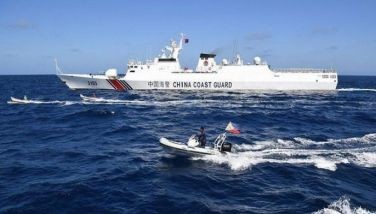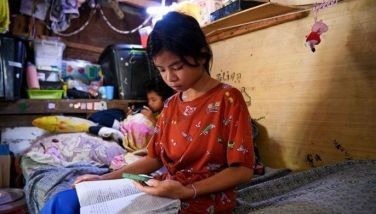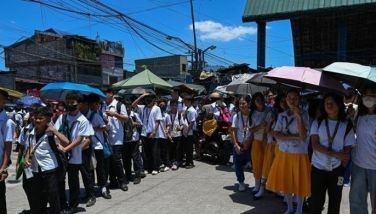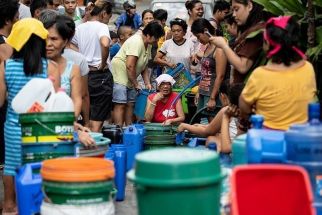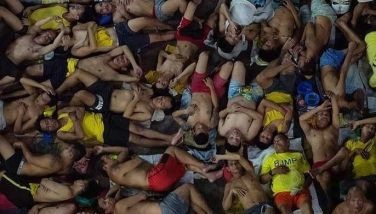Angat water level rises
MANILA, Philippines - The worst may be over for Metro Manila’s water crisis as the water level in the Angat dam rose overnight, raising hopes for fewer dry taps in the metropolis in the days ahead.
This developed as Malacañang thumbed down suggestions that President Aquino assume the role of “water czar” and wield greater powers in dealing with the problem.
“The water level has not deteriorated, it has increased and hopefully the worst is over,” Public Works Secretary Rogelio Singson told Palace reporters in a briefing, citing a “70-centimeter increase” in the dam’s water level, which was previously at 158.18 meters.
As a result, water available to consumers has increased to 1,844 million liters a day from the “lowest production level” of only 1,686 million liters per day on July 17, according to Singson.
Mr. Aquino has directed Singson, former president of Maynilad Water, to take charge of the water shortage problem.
Despite Angat dam’s higher water level, three cities – Caloocan, Manila and Quezon City – remain waterless for up to six hours daily. Reports said 117 barangays, including 32 villages, are without water at all.
But presidential spokesman Edwin Lacierda said there is no need for Mr. Aquino to act as water czar or declare a state of calamity in areas most affected by the water shortage.
“He’s (Mr. Aquino) been focusing on his mandate to solve the crisis. There is no need to install the President as water czar. And declaring a state of calamity will not change the situation. We’re calling on the public to please conserve water,” he said.
Also yesterday, Singson revealed that they have already proposed to the President a long-term plan for improving not only Metro Manila’s water supply but that of other urban centers as well.
“We have proposed to the President that instead of just focusing on Metro Manila, if you go further, you have a similar water shortage in most urban sectors. So we’re advocating a water supply sector program nationwide so that once and for all, we have access to potable water,” the DPWH chief said.
“There should be a supply and sanitation roadmap for us to move forward so we can avoid this perennial problem of water shortage,” he said.
Rationing continues
Water tanks, along with 100 fire trucks, have been deployed to areas worst hit by the water shortage.
A “cross-border arrangement” has also been made between Maynilad and Manila Water, where the latter – largely unaffected by the shortage – would provide water to Maynilad, according to Singson.
The DPWH chief also requested Defense Secretary Voltaire Gazmin to “provide warm bodies” who would keep order in places where there are long lines of people waiting for water rations.
“In the area of additional augmentation, the treatment plant in Putatan, Muntinlupa will be increased to another 25 million liters per day. The treatment plant will be producing 50 million liters per day, and areas around Muntinlupa will have access to clean potable water,” Singson said.
Singson also urged the public to report to authorities anyone found puncturing pipelines.
“We are appealing to the local government units to help us police and protect our water lines, it will affect everyone,” he said.
“Part of the work of the two concessionaires is getting in touch with the health officials just to avoid any outbreak (of disease),” he pointed out.
As Metro Manila residents make do with limited water supply, Climate Change Commission vice chairman Heherson Alvarez said a worse water supply scenario looms unless drastic measures are undertaken to address global warming.
“Failure to address global warming and climate change could lead to more horrible water problems like flash floods, drought and water supply shortage for domestic use,” Alvarez pointed out.
“We should conserve water in any way that we can,” he said.
Restoring order
A unit in the Armed Forces specifically trained as a counter-coup force said it is ready to help keep order in areas where there are long queues of people waiting for water rations.
AFP spokesman Brig. Gen. Jose Mabanta said they are coordinating with the DPWH and other concerned agencies regarding the deployment of two composite battalions – composed of 600 men – from the National Capital Region Command (NCRCOM).
Mabanta said troops from NCRCOM had performed similar security operations at the height of the rice crisis in Metro Manila two years ago, and during the onslaught of tropical storm “Ondoy” last year. He stressed the troops would only complement the Philippine National Police.
“We will just be involved in security, probably to see to it that the people in the (affected) areas will not push one another (during water distribution),” Mabanta said.
Reports said many people lining up for water particularly in depressed communities lost their temper and pushed their way ahead of others in line.
“The affected areas have very poor distribution services and it is important that we maintain security and see to it that the distribution is performed well,” Mabanta said.
Wawa dam use pushed
A real estate development firm has renewed its appeal to the Metropolitan Manila Waterworks and Sewerage System (MWSS) that it be allowed to develop the Wawa dam in Rodriguez (formerly Montalban), Rizal into an alternative water source for Metro Manila.
The San Lorenzo Ruiz Builders and Developers (SLRB), through its president Oscar Violago, said that although it holds the water rights over Wawa dam, it cannot proceed with its development because it still doesn’t have a permit from the National Water Resources Board (NWRB). It was the NWRB which granted SLRB exclusive rights over Wawa dam in 1993.
Violago said SLRB hopes to draw 1,500 million liters of water per day from the dam upon its development.
Violago added that his company would also need a purchase order from the MWSS to cover for the water it intends to supply to the MWSS for distribution.
Anthony Violago, the company’s vice president and Oscar’s son, said they can sell water sourced from the Wawa dam to the MWSS for P16 per cubic meter, which he said is the lowest price.
The SLRB said a rehabilitated Wawa dam would be capable of producing 80 million liters of water per day in just eight months of operation; 900 million liters per day in two years and 1,500 million liters in four years.
The elder Violago said his company could revive the Wawa dam just as it had developed the Casecnan dam in Nueva Ecija at a cost of $687 million.
“We need the MWSS and the NWRB to cooperate with us at no cost to them, to develop Wawa dam like what we did for Casecnan dam,” he said.
The SLRB said reviving the Wawa dam could cost $600 million. The SLRB’s rehabilitation plan for Wawa has already attracted local and European investors. SLRB officials declined to name the investors.
He added that had they been given the chance to develop the Wawa dam early enough, the current water crisis could have been averted.
The volume of water in Angat dam has already dropped to 1,100 million liters per day, according to Violago.
“This means that we could still give the 400 MLD (million liters per day) produced to farmers in Bulacan whose water supply is always affected during the dry season,” he said.
The Wawa dam supplied water to Metro Manila from 1908 to 1968, when the MWSS abandoned it in favor of the larger Angat dam.
Not Napocor’s fault
Meanwhile, Albay Gov. Joey Salceda defended the National Power Corp. from accusations that it was to blame for the water crisis because it had released an excessive volume of water from Angat dam last year.
“There’s a need to maintain a healthier respect for science and for the scientific community in our government,” Salceda said.
“Politicians who try to run our dams is a reflection of an anatomy of ‘hysteriocracy,’” he said.
“And yes, all these national sufferings are mostly self-imposed since at this state of our political development cycle, we tolerate or even encourage politicians to run our dams.”
He said there should be an acknowledgement that the country is vulnerable to the effects of climate change, which manifested in extreme conditions such as the massive floods due to Ondoy and typhoon “Pepeng” in September and October last year and the drought which started in December last year and lasted up to June this year.
“One gnawing suspicion I probably share with many is that our responses to both have largely aggravated their supposed impacts,” Salceda said.
For Bulacan Bishop Jose Oliveros, Maynilad and not Napocor is to blame for the water shortage because of its failure to aggressively fix water leakages.
“It is Maynilad who is at fault here because 50 percent of the water they get from the Angat dam is wasted on the leakages caused by damaged pipes,” Oliveros said over Church-run Radio Veritas.
“They should have done something about that a long time ago,” he pointed out.
He also said there might be no more need for Oratio imperata or special prayers for rain since the rainy season has already arrived.
“The water shortage is only artificial... It is already the rainy season, if you have the prayer of Oratio imperata we might experience flooding problems because this situation is only artificial,” Oliveros said. With Evelyn Macairan, Rhodina Villanuevaa, Celso Amo, Mike Frialde, Cecille Suerte Felipe, Jaime Laude
- Latest
- Trending















